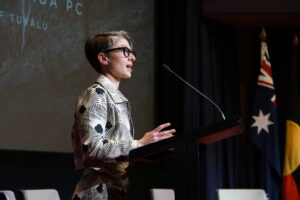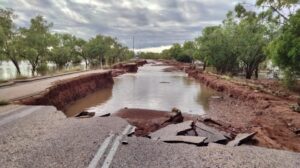Australia is in the midst of a housing crisis. Record numbers of Australians are in severe housing stress and it’s not just people with rising interest rates on their mortgages. Fewer and fewer people can afford a roof over their head and more and more people are sleeping rough on the streets or in their car.
Unfortunately, just as it did with the Safeguard Mechanism, the federal government is overcomplicating the policy response while ignoring the obvious solutions.
Across the country, 640,000 people need social homes, that’s more than the combined populations of Canberra and Darwin. Some people have been on waiting lists for as long as 10 years. In Canberra, the current social housing shortage is 3100 homes, according to independent ACT senator David Pocock.
How is the federal government proposing to tackle this urgent crisis? Not by building more social homes. Instead of building more social housing directly, the government plans to set up the Housing Australia Future Fund (HAFF) – an investment portfolio on the stock market.
If the fund makes enough money, and if businesses and developers take up the incentives, then the government hopes to use any returns to build 30,000 homes over five years.
Even if the housing fund succeeds in generating a return, sadly it will be nowhere near enough to truly tackle Australia’s 640,000 shortfall in social housing. It won’t even replace the number of affordable homes we’re set to lose. It’s a wishy-washy solution for a bricks and mortar problem.
In short, the government says its policy will tackle the substantial housing crisis without actually spending a substantial amount of money on housing.
The government will loan $10 billion to the fund, and then take that money back after five years. Given the structural revenue problem in the budget, the cost-of-living crisis, it is easy to see why this complicated approach is politically appealing to the government.
But, as some have pointed out, there are simpler solutions. The HAFF will not pass the Senate without Greens support and that isn’t looking straight forward. Max Chandler-Mather, Greens spokesperson for Housing, recently said at a rally on the lawns of Parliament on Tuesday: “the bottom line is we do not fund schools or hospitals like that, by gambling on the stock market”.
There are ideas on the table to make the government’s plan worthwhile. Senator David Pocock is calling on the government to double the size of the fund, saying: “We desperately need a stronger response to such a huge and acute crisis”.
The government could top up the housing fund with real money every year. It could turn its aspirational 30,000 social housing target into a binding commitment.
But there are options beyond stock market speculation. Remember the 2019 election? Then, Labor under Bill Shorten was committed to delivering 300,000 social and affordable homes over 10 years. That plan would have been a real turning point, and life changing for many Australians.
But all of those ideas involve public spending. And for all its talk about urgency, the government seems determined not to spend any actual money building or purchasing actual homes.
Which is weird, because it’s not like governments don’t know how to build or buy housing stock for public purposes. Defence Housing Australia houses ADF personnel and it is largely self -funding. Who knew investing in property was profitable?
Senator David Pocock has also pointed out that Australia will spend around 10 times as much on tax concessions for property investors than the HAFF will generate, best-case-scenario.
That’s around $10 billion a year on tax breaks to make a second, third or fourth investment property more affordable for investors, but just $500 million a year – provided the stock market doesn’t tank – to build social housing for people with zero homes.
The crisis in social housing is obviously the most acute housing problem, but Australia’s housing problems only start there. There has been a significant drop in home ownership across the generations.
Millennials are the first generation with fewer than half owning a home by the age of 35; and, between 1996 and 2021 the percentage of people aged 25-54 who rent rose from one quarter to one third.
And there is now a big disconnect between wages growth and house price growth. In the decade to September 2013, NSW wages growth (41.8 per cent) outstripped the median Sydney house price growth (39.6 per cent). But between December 2013 and December 2022, NSW wages grew by 22.2 per cent while median Sydney house prices grew by 70.5 per cent.
Just as the Safeguard Mechanism avoids the most straightforward, obvious way to tackle the climate crisis (a carbon tax, banning new fossil fuel projects, ending native forest logging, ending fossil fuel subsidies), setting up an investment fund rather than just building social housing seems an unnecessarily complicated response to the housing crisis.
The upcoming budget in May will, as usual, be the purest expression of government priorities. But currently, there appears to be an infinite amount to spend on nuclear submarines, tax cuts for the rich, and tax breaks for property speculators while nothing for those experiencing homelessness.
Perhaps as concerning is the insidious trend that the stock market, not the state, is the default policy tool of choice for delivering essential services, or saving species from extinction as the Environment Minister has announced.
The estimated cost of fixing the social housing shortfall of $35 billion between now and 2035 might sound like a lot. But compared to the half a trillion dollar price tag of the Stage 3 tax cuts and nuclear submarines, it’s an absolute bargain.
Between the Lines Newsletter
The biggest stories and the best analysis from the team at the Australia Institute, delivered to your inbox every fortnight.
You might also like
The Climate Crisis is an Integrity Crisis | Polly Hemming
I am starting my address to this year’s summit in the exact same way that I started last year’s address. Because it is just over a year since I delivered these same words, which aren’t actually my words. They are the words of our Climate Change Minister, and they provide a baseline of sorts for what progress has been made in that time.
Majority of Australians support fossil fuel industry paying for the costs of climate change
A significant majority of Australians (at least 75%) are concerned about the impact of the climate crisis on food supply, agriculture and insurance premiums, and support policies that would force fossil fuel companies to pay for the damage they are causing, according to the Australia Institute’s 2023 Climate of the Nation report.
Why You’re Paying More Tax Even Though Real Wages Are Shrinking
It’s a bitter irony.


